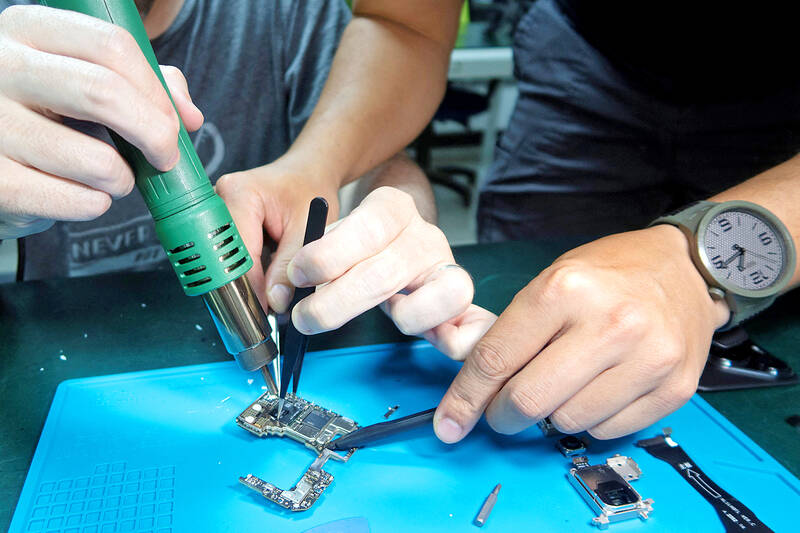Huawei Technologies Co’s (華為) latest high-end smartphone features more Chinese suppliers, including a new flash memory chip and an improved chip processor, a teardown analysis showed, pointing to the progress China is making toward technology self-sufficiency.
The inside of Huawei’s Pura 70 Pro was examined by online tech repair company iFixit and consultancy TechSearch International, finding components made by Chinese suppliers.
The firms also found that the Pura 70 phones run on an advanced processing chipset made by Chinese chip foundry Semiconductor Manufacturing International Corp (SMIC, 中芯) called the Kirin 9010, which is likely a slightly improved version of the advanced chip used by Huawei’s Mate 60 series.

Photo: Reuters
“While we cannot provide an exact percentage, we’d say the domestic component usage is high, and definitely higher than in the Mate 60,” iFixit lead teardown technician Shahram Mokhtari said.
“This is about self-sufficiency, all of this, everything you see when you open up a smartphone and see whatever are made by Chinese manufacturers, this is all about self-sufficiency,” Mokhtari said.
The Pura 70 series launched late last month and quickly sold out.
Earlier analysis by teardown firms such as TechInsights of the Mate 60, launched in August last year, found that the phone used DRAM and NAND memory chips made by South Korea’s SK Hynix.
SK Hynix said at the time that it no longer works with Huawei, and analysts said the chips likely came from stockpiles.
The Pura 70 still contains a DRAM chip made by SK Hynix while the NAND flash memory chip was likely packaged by Huawei’s in-house chip unit, HiSilicon (海思), with each NAND die bearing a 1-terabit capacity, iFixit and TechSearch found.
This is comparable to products made by major flash memory producers such as SK Hynix, Kioxia and Micron.
“In our teardown, our chip ID expert has identified it as a particular HiSilicon chip,” Mokhtari said.
The processor used by the Puro 70 Pro suggests that Huawei might have only made incremental improvements to its ability to produce an advanced chip with Chinese partners in the months since it launched the Mate 60 series, iFixit and TechSearch said.
The processor is similar to the one in the Mate 60 series, which used SMIC’s 7-nanometer N+2 manufacturing process, they said.
“This is significant, because news of the 9000S on 7-nanometer nodes caused a bit of a panic last year when US lawmakers were confronted with the possibility that the sanctions imposed on Chinese chipmakers might not slow their technological progress after all,” iFixit said.
“The fact that the 9010 is still a 7-nanometer process chip, and that it’s so close to the 9000S, might seem to suggest that Chinese chip manufacturing has indeed been slowed,” iFixit added.
Huawei should not be underestimated, as SMIC is still expected to make a leap to a 5-nanometer manufacturing node before the end of the year, Mokhtari said.

The US dollar was trading at NT$29.7 at 10am today on the Taipei Foreign Exchange, as the New Taiwan dollar gained NT$1.364 from the previous close last week. The NT dollar continued to rise today, after surging 3.07 percent on Friday. After opening at NT$30.91, the NT dollar gained more than NT$1 in just 15 minutes, briefly passing the NT$30 mark. Before the US Department of the Treasury's semi-annual currency report came out, expectations that the NT dollar would keep rising were already building. The NT dollar on Friday closed at NT$31.064, up by NT$0.953 — a 3.07 percent single-day gain. Today,

‘SHORT TERM’: The local currency would likely remain strong in the near term, driven by anticipated US trade pressure, capital inflows and expectations of a US Fed rate cut The US dollar is expected to fall below NT$30 in the near term, as traders anticipate increased pressure from Washington for Taiwan to allow the New Taiwan dollar to appreciate, Cathay United Bank (國泰世華銀行) chief economist Lin Chi-chao (林啟超) said. Following a sharp drop in the greenback against the NT dollar on Friday, Lin told the Central News Agency that the local currency is likely to remain strong in the short term, driven in part by market psychology surrounding anticipated US policy pressure. On Friday, the US dollar fell NT$0.953, or 3.07 percent, closing at NT$31.064 — its lowest level since Jan.

The New Taiwan dollar and Taiwanese stocks surged on signs that trade tensions between the world’s top two economies might start easing and as US tech earnings boosted the outlook of the nation’s semiconductor exports. The NT dollar strengthened as much as 3.8 percent versus the US dollar to 30.815, the biggest intraday gain since January 2011, closing at NT$31.064. The benchmark TAIEX jumped 2.73 percent to outperform the region’s equity gauges. Outlook for global trade improved after China said it is assessing possible trade talks with the US, providing a boost for the nation’s currency and shares. As the NT dollar

The Financial Supervisory Commission (FSC) yesterday met with some of the nation’s largest insurance companies as a skyrocketing New Taiwan dollar piles pressure on their hundreds of billions of dollars in US bond investments. The commission has asked some life insurance firms, among the biggest Asian holders of US debt, to discuss how the rapidly strengthening NT dollar has impacted their operations, people familiar with the matter said. The meeting took place as the NT dollar jumped as much as 5 percent yesterday, its biggest intraday gain in more than three decades. The local currency surged as exporters rushed to